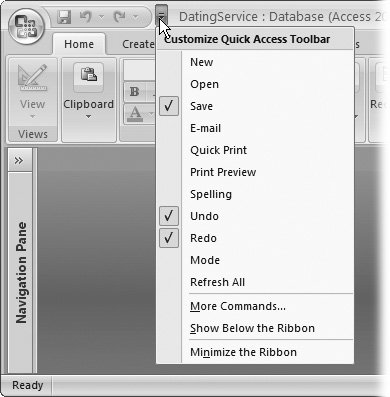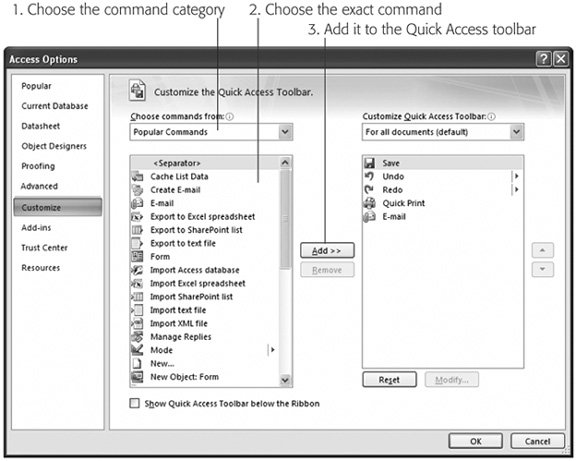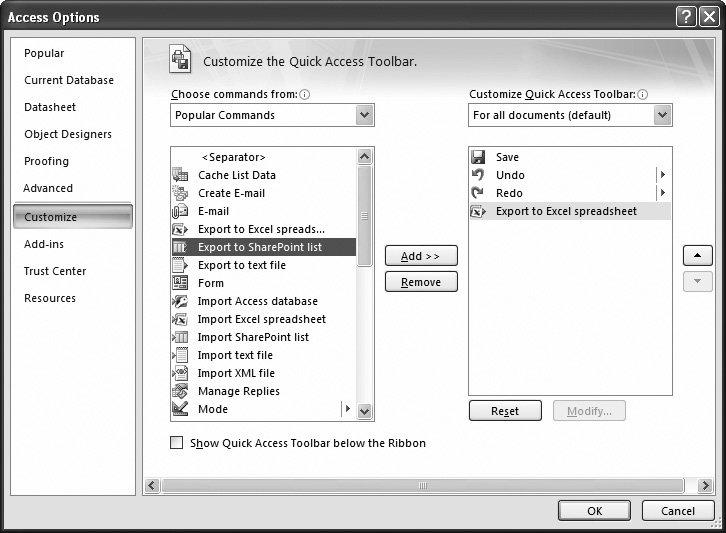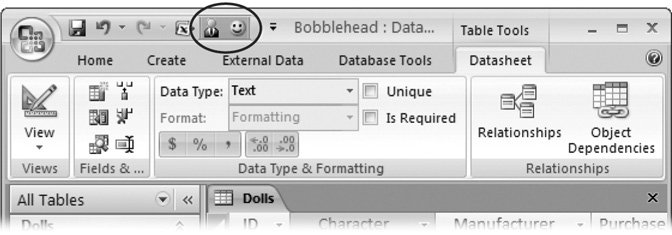A.1. The Quick Access Toolbar You've already seen the Quick Access toolbar (known to Access nerds as the QAT). It's the micro- sized toolbar that sits above the ribbon. The Quick Access toolbar has only icons, but you can hover over a button if you want to see a label describing what it does. When you first start out with Access, the Quick Access toolbar's a lonely place, with buttons for quickly saving the current database object and undoing or redoing the last action (Section 1.3.1). However, Access gives you complete control over this space, including the ability to add new buttons. The quickest way to add buttons is by clicking the downward-pointing arrow shown in Figure A-1.  | Figure A-1. When you click the drop-down arrow on the Quick Access toolbar, Access shows a list of often-used commands that you can add just by clicking them. These commands include ones for creating a new database, opening an existing database, sending the current database object (the one that's selected in the navigation pane) to the printer with no questions asked, emailing the data from the current database object, and firing up the spell checker. But to see all your possibilities, you need to choose More Commands. | |
Note: If you don't like the Quick Access toolbar's placement, Access gives you one other option. Click the drop-down arrow, and then choose Show Below the Ribbon to move your toolbar under the ribbon so your mouse has less distance to travel.
You can add buttons to the Quick Access toolbar for two reasons: -
To make it easier to get to a command you use frequently . If it's in the Quick Access toolbar, then you don't need to memorize a keyboard shortcut or switch to a different tab in the ribbon. -
To get to a command that the ribbon doesn't provide . Access has a small set of unpopular commands that it lets you use but that it doesn't keep in the ribbon. Many of these commands are holdovers from previous versions of Access. If you have a long-lost favorite Access feature that's missing, it just may be available using the Quick Access toolbar's extra buttons. (The next section shows you how to peruse the full complement of available buttons.) Keyboard lovers can also trigger the commands in the Quick Access toolbar with lightning speed, thanks to Access's KeyTips feature (Section 3.2.1). When you press the Alt key, Access displays a number superimposed over every command in the Quick Access toolbar (starting at 1 and going up from there). You can then press the number to trigger the command. So in the Quick Access toolbar shown in Figure A-1, Alt+1 saves the currently open database object, Alt+2 triggers the Undo command, and so on.
Tip: If you want to add a command that duplicates something that's already in the ribbon, here's a shortcut: Find the command in the ribbon, right-click it, and then choose Add to Quick Access Toolbar.
A.1.1. Adding Buttons To add a button to the Quick Access toolbar, follow these steps: -
Click the drop-down arrow on the Quick Access toolbar, and then choose More Commands . The Access Options dialog box opens and positions you at the Customize section (Figure A-2).  | Figure A-2. The Customize section of the Access Options window has two areas. The list on the left lets you choose the command you want to add. The list on the right shows the commands that currently appear in the Quick Access toolbar. | | -
Choose a category from the "Choose commands from" list . The library of commands that you can add to the Quick Access toolbar is enormous . To make it easier to find what you want, Access divides your choices into a collection of categories. Many of the categories overlapAccess simply provides them to make finding what you want easier. Here are the top choices: -
Popular Commands gives you a short list of commands that Access jockeys love. If you're trying to get quick access to a commonly used feature, you'll probably find it here. -
Commands Not in the Ribbon provides all the leftoverscommands that Microsoft didn't consider useful enough to include in the ribbon. This list holds some commands that are superseded or partially duplicated by other commands, commands that are included in other dialog boxes, and commands that were used in previous versions of Access and put out to pasture in this release. -
All Commands includes the full list of choices. As with the other categories, it's ordered alphabetically . -
Macros shows all the macros in the currently open database. However, there's a problem here: If you add a macro command to the Quick Access toolbar, it won't work in other databases because they don't have the same macro. The solution is to use another Access feature that lets you customize how the Quick Access toolbar appears in specific databases. Full details are in Section A.1.2. Under these categories are several additional categories that correspond to the Office menu and various tabs in the ribbon. For example, you can choose the Create tab to see all the commands that appear in the ribbon's Create tab. -
Once you've chosen the category you want, pick the command from the list below, and then click Add . The command moves from the list on the left to the list on the right, placing it on the Quick Access toolbar (Figure A-3). -
You can repeat this process (starting at step 2) to add more commands . Optionally, you can rearrange the order of items in the Quick Access toolbar. Just pick a command, and then use the up and down arrow buttons to move it. The topmost commands in the list are displayed to the left on the Quick Access toolbar.
Tip: If you've customized the heck out of your Quick Access toolbar and want to go back to a simpler way of life, just click the Reset button.
-
When you're finished, click OK to return to Access with the revamped Quick Access toolbar . Adding a Quick Access toolbar isn't a lifetime commitment. To get rid of a command you don't want anymore, right-click it, and then choose Remove from Quick Access Toolbar.  | Figure A-3. In this example, the Export to Excel spreadsheet command is being added to the Quick Access toolbar, so you can speedily export the contents of the current table without rifling through the ribbon. | |
Note: You may notice the tempting Modify button, which lets you change a command's name and picture. Unfortunately, it works only for macro commands.
A.1.2. Customizing Specific Databases Do you have a button or two that you're using incessantly, but just for a specific database? In this situation, it may not make sense to customize the Quick Access toolbar in the normal way. If you do, then you'll get your extra buttons in every database you use, including those where the commands aren't useful. Access has a great feature to help you out in this situation. You can customize the Quick Access toolbar for an individual database. That way, whenever you open that database, the buttons you need appear in the Quick Access toolbar. When you close it (or open another database in a separate window), the buttons disappear.
Note: Customizing individual databases has advantages and disadvantages. The disadvantage is that you need to perform this task separately for every database, which can take a lot of time. The advantage is that your customizations are recorded right in your database file. As a result, they stick around even if you open the database on someone else's computer.
To customize the toolbar for a single database, you follow the same steps that you used in the previous section. Start by clicking the Quick Access toolbar's drop-down arrow, and then choose More Commands. However, before you add any commands, change the selection in the "Customize Quick Access Toolbar" drop-down menu, which appears just above the list of commands in the Quick Access toolbar. Instead of using "For all documents (default)", choose your database's name (as in "For C:\MyFiles\SecretSanta.accdb"). This list starts off empty. Then, follow the normal steps to add buttons. When Access displays the Quick Access toolbar, it combines the standard buttons (as configured in the previous section) with any buttons you've defined for the current database. Figure A-4 shows an example.  | Figure A-4. The database-specific buttons (circled) always appear after the standard buttons and have a slightly different appearance (a darker background). | |
Customizing the Quick Access toolbar for a specific database is a useful trick. It makes great sense with macros, because it lets you create a single database that has a useful set of macros and handy buttons for running them. For example, you could create macros that show specific forms in your database, and then add them to the Quick Access toolbar. That way, the user can zip around your database without using the navigation pane. |



